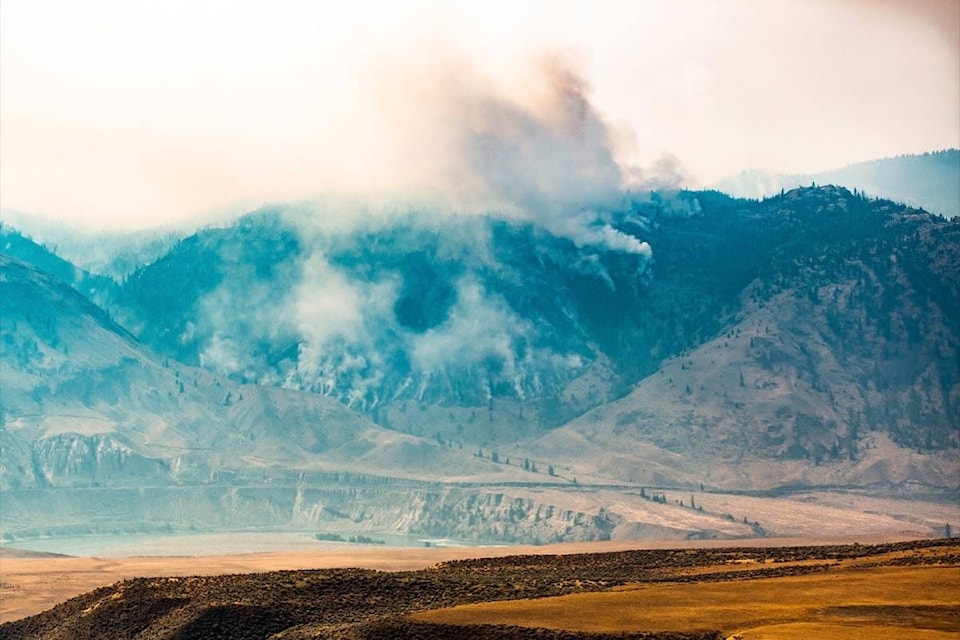As of Tuesday July 20, the Tremont Creek wildfire east of Ashcroft was estimated by BC Wildfire Service to be 10,916 hectares in size. The fire was reported on July 13, and is part of the Lytton complex, which includes the Lytton Creek and George Road fires.
The Villages of Ashcroft and Cache Creek, the Ashcroft Indian Band, and parts of TNRD area “I” remain on evacuation alert. Areas around Barnes Lake and near Walhachin remain under evacuation order, including Koppers (the tie plant) on Evans Road.
A map of all evacuation alerts and orders in the TNRD can be found at https://bit.ly/3dcIk0L. At the time of writing, Ashcroft, Cache Creek, and the Ashcroft Band were not considered under threat. The fire had also not jumped either Highway 1 or the Thompson River east of Cache Creek; no structures had been destroyed and no lives have been lost. Structural protection was in place around Barnes Lake Road, Walhachin, and the bridge across the Thompson River to Walhachin.
On July 18 the area around Barnes Lake was put under an area restriction by the BC Wildfire Service (BCWS). This is not an evacuation alert or order; it means that a person must not remain in or enter the restricted area without prior written authorization, unless the person enters the area only in the course of:
(a) Travelling as a person acting in an official capacity.
(b) Travelling for the purpose of supporting wildfire suppression activities.
(c) Travelling as a person working for Highland Valley Copper Mine to and from the mine site for the purposes of maintaining critical infrastructure at the site.
(d) Travelling to or from his or her principle residence, that is not under an evacuation order.
(e) Travelling to or from private or leased property for the purposes of accessing a secondary residence or recreational property, that is not under an evacuation order.
(f) Engaging and/or participating in agricultural activities pertaining to livestock or agriculture management on private or leased property.
(g) Using a highway as defined in the Highway Act (e.g. use of travelling along Highway 97C).
The area restriction in place currently has an expiry date of Oct. 15, 2021. However, once the area is considered safe for entry, BCWS will rescind the order.
On July 20, 43 firefighters had been assigned to the fire, with structural protection ongoing. There were 20 pieces of heavy equipment on scene, as well as six helicopters. A 25 kilometre fire guard at the southwest corner through to the south flank has been established near Barnes Lake Road and has been reinforced with retardant.
BC Wildfire Service has said that it will be establishing a fire camp in Cache Creek, adjacent to the Cache Creek Community Park. The Ashcroft Fire Department has been on site near Barnes Lake almost every every night doing structural protection. The Cache Creek Fire Department is on standby to help with fire protection in Ashcroft if needed.
The Village of Ashcroft is in constant contact with Emergency Management BC regarding the fire, and will be releasing updates each weekday on the Village of Ashcroft Facebook page, website (https://ashcroftbc.ca/), and a poster at the post office. After hours/weekend information will only be posted when emergent information must be communicated immediately.
Interior Health has proactively moved residents from Jackson House at the Ashcroft Hospital and Health Site to accommodation in Kamloops.
As of midnight on Tuesday, July 20 a provincial State of Emergency is in place for the entire province.
Evacuation alerts are issued to prepare residents in case they need to evacuate their premises or property should it be found necessary. Residents will be given as much advance notice as possible prior to evacuation; however, there might be limited notice due to changing conditions. Those under evacuation alert should:
• Locate all family members and designate a meeting area outside the evacuation area, should an evacuation order be called while separated. If an alert becomes an order while you are outside the affected area, you will not be able to return, so if you have to travel outside the community take necessary/important items with you.
• Pack essential items such as government-issued ID, medications, eyeglasses, valuable papers (e.g. insurance, credit, and mortgage information), immediate care needs for dependents and, if time and space permits, keepsakes for quick departure.
• Refill prescriptions, if needed, and make sure all necessary medication is on hand.
• Prepare to move disabled persons, children, and/or neighbours, if assistance is needed.
• Prepare to take pets with you and move livestock to a safe area (if possible).
• Arrange transportation for all your household members. Fill the gas tanks of personal vehicles.
• Arrange accommodation for all members of the residence, if possible.
• Wait for an evacuation order to be issued before evacuating. Evacuation orders will contain information about the preferred evacuation route and where to report to for Emergency Support Services. If an evacuation order is issued, residents must leave immediately.
The Canadian Red Cross is encouraging people under evacuation order due to wildfires to register with the Red Cross by calling 1-800-863-6582 between the hours of 9 a.m. and 5 p.m. PST.
People who have already registered with British Columbia Emergency Support Services (https://ess.gov.bc.ca), or are staying with family and friends, are also encouraged to register with the Red Cross. Registration ensures people can be contacted while away from home, and can also be reached with information on further Red Cross services and other assistance that may become available to them during this time of need.
For further information visit www.bcwildfire.ca and www.tnrd.ca/emergency-services.
editorial@accjournal.ca
Like us on Facebook and follow us on Twitter
